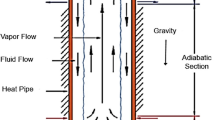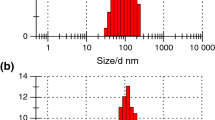Abstract
The aim of this study is to improve the thermal performance of air-to-air heat recovery units, containing heat pipes by using graphene/water nanofluid as a working fluid. The experimental set up of this work consists of two air ducts. To study the effect of the airflow rate and the temperature on the performance of the heat recovery unit, different values of airflow rates and temperatures are used. The values of Re numbers are calculated for each air duct. These Re numbers referred to the turbulent flow type in all cases. To compare the results of the graphene/water nanofluid and the pure water working fluid, thermal efficiency and thermal resistance values are calculated for both of them. The results showed that the graphene/water nanofluid was more efficient than pure water in all different conditions. Re number in the cold air duct was 6800, and the Re number in the hot air duct was 9000. The maximum thermal efficiency values were 34.1 % and 20.1 % for graphene/water nanofluid and pure water, respectively. The maximum improvement rate in thermal efficiency was 87.7 % when the average Re number in cold and hot air ducts was equal to 11,150 and 11,650, respectively. By comparing the results of graphene/water nanofluid with those of the pure water, it can be seen that using graphene/water nanofluid decreased the thermal resistance of the heat pipes. Therefore, the heat transfer increased. The maximum decreasing value of the thermal resistance was 52.3 % when cold and hot air duct Re numbers were 11,700 and 11,000, respectively.











Similar content being viewed by others
Abbreviations
- \({\text{c}}_{{\text{p}}}\) :
-
Specific heat of air [kJ⋅kgK−1]
- \({\text{c}}_{{{\text{p}},{\text{bf}}}}\) :
-
Specific heat of the base fluid [kJ⋅kgK−1]
- \({\text{c}}_{{{\text{p}},{\text{nf}}}}\) :
-
Specific heat of nanofluid [kJ⋅kgK−1]
- \({\text{D}}_{{\text{h}}}\) :
-
Hydraulic diameter [m]
- \({\text{k}}_{{\text{f}}}\) :
-
Thermal conductivity of the base fluid [W⋅mK−1]
- \({\text{k}}_{{\text{p}}}\) :
-
Thermal conductivity of nanoparticle [W⋅mK−1]
- \({\text{k}}_{{{\text{static}}}}\) :
-
Static thermal conductivity of nanofluid [W⋅mK−1]
- \({\dot{\text{m}}}\) :
-
Mass flow of air [kg⋅s−1]
- \({\dot{\text{Q}}}_{{\text{c}}}\) :
-
The amount of heat transfer in the condenser [W] \({\dot{\text{Q}}}_{{\text{e}}}\): The amount of heat transfer in the evaporator [W]
- R:
-
Thermal resistance [K⋅W−1]
- Re:
-
Reynolds number
- T:
-
Temperature (°C)
- \({\text{V}}_{{{\text{ave}}}}\) :
-
Average velocity of air [m⋅s−1]
- \({\uprho }_{{{\text{air}}}}\) :
-
Air density [kg⋅m−3]
- \({\upeta }\) :
-
Efficiency
- \({\upmu }\) :
-
Dynamic viscosity [kg⋅ms−1]
- \({\upmu }_{{{\text{bf}}}}\) :
-
Viscosity of the base fluid [kg⋅ms−1]
- \({\upmu }_{{{\text{nf}}}}\) :
-
Nanofluid viscosity [kg⋅ms−1]
- \(\varphi_{{{\text{np}}}}\) :
-
Concentration of nanofluid [%]
References
F. Nasirzadehroshenin, H. Maddah, H. Sakhaeinia, A. Pourmozafari, Int. J. Thermophys. 40, 9 (2019)
I. Wole-osho, E.C. Okonkwo, S. Abbasoglu, D. Kavaz, Int. J. Thermophys. 41, 157 (2020)
Y. Shimoda, T. Aoyama, H. Kaneko, Y. Onumata, F. Okada, Int. J. Thermophys. 34, 7 (2013)
S.U. Khan, H.M. Ali, Int. J. Thermophys. 41, 11 (2020)
H. Jouhara, A. Chauhan, T. Nannou, S. Almahmoud, B. Delpech, L. C. Wrobel, Energy 128 (2017)
A. Faghri, Heat Pipe Science and Technology (Taylor & Francis Global Digital Press, New York, 1995).
G. Huminic, A. Huminic, Exp. Therm. Fluid Sci. 35, 3 (2011)
A. Öztürk, M. Özalp, A. Sözen, M. Gürü, Therm. Sci. 23, 3B (2017)
N.K. Gupta, A.K. Tiwari, S.K. Ghosh, Exp. Therm. Fluid Sci. 90, 84–100 (2018)
A. Arshad, M. Jabbal, Y. Yan, D. Reay, J. Mol. Liquids 279, 444–484 (2019)
J. Liu, F. Wang, L. Zhang, X. Fang, Z. Zhang, Renew. Energy 63, 519–523 (2014)
Y. Wang, H.A.I. Al-Saaidi, M. Kong, J.L. Alvarado, Int. J. Heat Mass Transf. 119, 223–235 (2018)
H. Yarmand et al., Energy Convers. Manag. 100, 419–428 (2015)
S. Askari, H. Koolivand, M. Pourkhalil, R. Lotfi, A. Rashidi, Int. Commun. Heat Mass Transf. 87, 30–39 (2017)
J.E. Proctor, D.A.M. Armada, A. Vijayaraghavan, An Introduction to Graphene and Carbon Nanotubes (CRC Press, Boca Raton, 2017).
S. Mishra, D. Hansora, Graphene Nanomaterials: Fabrication, Properties and Applications (Pan Stanford Publishing Pte. Ltd., Singapore, 2018).
B. Takabi, S. Salehi, Adv. Mech. Eng. 6, 147059 (2014)
B. Teymur, C. Ozalp, J. Comput. Theor. Nanosci. 14, 2817–2828 (2017)
H.C. Brinkman, J. Chem. Phys. 20, 4 (1952)
M. Sheikholeslami, D.D. Ganji, Comput. Methods Appl. Mech. Eng. 283, 651–663 (2015)
M. Aramesh, F. Pourfayaz, M. Haghir, A. Kasaeian, M. Ahmadi, Proc. Inst. Mech. Eng. Part A 1, 1 (2019)
Author information
Authors and Affiliations
Corresponding author
Rights and permissions
About this article
Cite this article
Sözen, A., Filiz, Ç., Aytaç, İ. et al. Upgrading of the Performance of an Air-to-Air Heat Exchanger Using Graphene/Water Nanofluid. Int J Thermophys 42, 35 (2021). https://doi.org/10.1007/s10765-020-02790-w
Received:
Accepted:
Published:
DOI: https://doi.org/10.1007/s10765-020-02790-w




